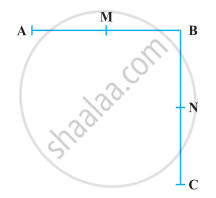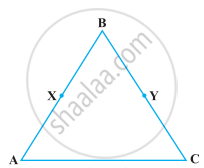Advertisements
Advertisements
प्रश्न
In the following figure AB = BC, M is the mid-point of AB and N is the mid-point of BC. Show that AM = NC.

उत्तर
Given, AB = BC ...(i)
M is the mid-point of AB.
∴ AM = MB = `1/2` AB ...(ii)
And N is the mid-point of BC.
∴ BN = NC = `1/2` BC ...(iii)
According to Euclid’s axiom, things which are halves of the same things are equal to one another.
From equation (i), AB = BC
On multiplying both sides by `1/2`, we get
`1/2` AB = `1/2` BC
⇒ AM = NC ...[Using equations (ii) and (iii)]
APPEARS IN
संबंधित प्रश्न
Give a definition of the following term. Are there other terms that need to be defined first? What are they, and how might you define them?
line segment
Consider two ‘postulates’ given below:-
- Given any two distinct points A and B, there exists a third point C which is in between A and B.
- There exist at least three points that are not on the same line.
Do these postulates contain any undefined terms? Are these postulates consistent? Do they follow from Euclid’s postulates? Explain.
If a point C lies between two points A and B such that AC = BC, point C is called a mid-point of line segment AB. Prove that every line segment has one and only one mid-point.
In how many points two distinct planes can intersect?
How many least number of distinct points determine a unique plane?
Greek’s emphasised on ______.
‘Lines are parallel, if they do not intersect’ is stated in the form of ______.
The boundaries of the solids are curves.
“For every line l and for every point P not lying on a given line l, there exists a unique line m passing through P and parallel to l ” is known as Playfair’s axiom.
Solve the following question using appropriate Euclid’s axiom:
In the following figure, we have AB = BC, BX = BY. Show that AX = CY.

